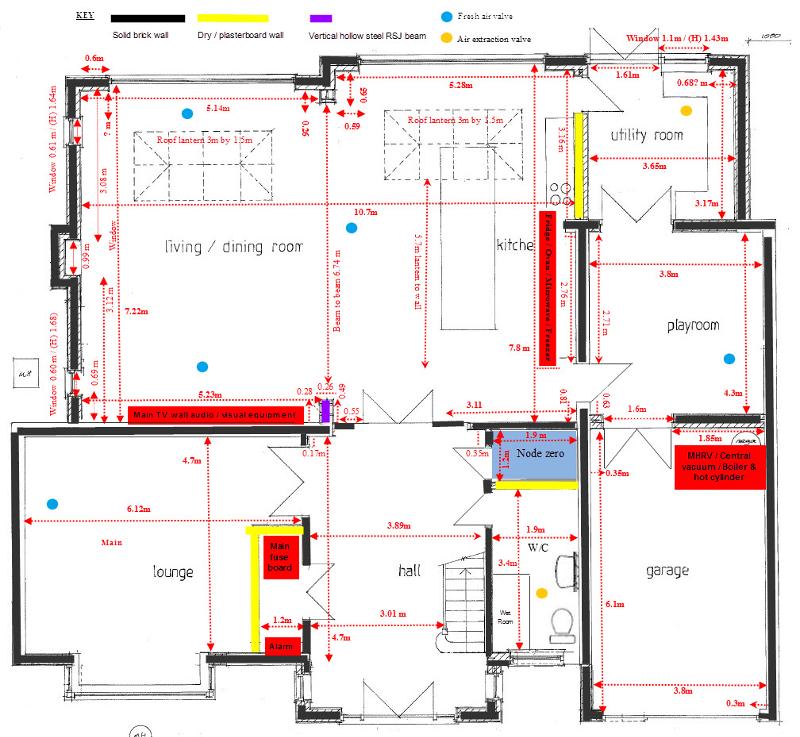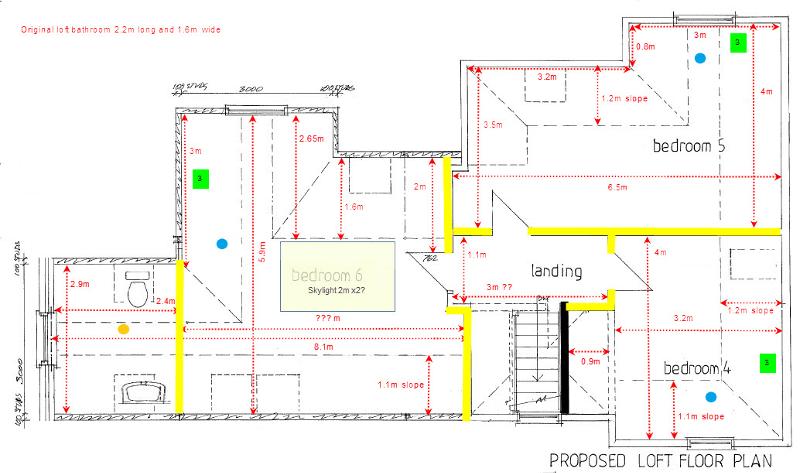u587162
asked on
Network design for home and what electrical devices will or could interfere with ethernet cables
So as some of you may know, due to my several questions in the last few days on Cat 6, 6a and 6e cables, I am cabling my home as part of a new build. I am based in the UK.
Please see the following images which show the layout of my three floors. The bright green small square boxes indicate the number of ethernet ports I plan to put in each room. They may not all be located at that spot and may not all be used as ethernet ports. Possibly for smart TV, PoE devices including home automation and maybe phone, but I am trying to future proof.
Can I please have any comments on possible interference issues I might face based on the bright red boxes I have included which name the various electrical equipment.
I will go with Cat 6 cable although Cat 6a is an option for the extra £50 I need to spend for the 300m reel of cable (costing approx. £ 150).



Please see the following images which show the layout of my three floors. The bright green small square boxes indicate the number of ethernet ports I plan to put in each room. They may not all be located at that spot and may not all be used as ethernet ports. Possibly for smart TV, PoE devices including home automation and maybe phone, but I am trying to future proof.
Can I please have any comments on possible interference issues I might face based on the bright red boxes I have included which name the various electrical equipment.
I will go with Cat 6 cable although Cat 6a is an option for the extra £50 I need to spend for the 300m reel of cable (costing approx. £ 150).



ASKER
Attached with revised ground floor plan showing the ethernet sockets proposed.
Should I consider an air supply valve in the Node Zero room where all cables will come back to, or an air extraction valve?
Will this room get very hot if only cables, switches, hub and maybe camera PVR box is located there?

Should I consider an air supply valve in the Node Zero room where all cables will come back to, or an air extraction valve?
Will this room get very hot if only cables, switches, hub and maybe camera PVR box is located there?
SOLUTION
membership
This solution is only available to members.
To access this solution, you must be a member of Experts Exchange.
With regard to the additional Q about overheating, with a small amount of equipment you should be fine as long as there is an external airflow. This only falls down if the air outside is regularly too warm, in which case a low end aircon unit may be best.
SOLUTION
membership
This solution is only available to members.
To access this solution, you must be a member of Experts Exchange.
Actually, plenum rated cables are only required in air plenums. Most homes do not use use plenums for air return and are therefor not required. However, it's always good to check local building codes.
That said, it is always good practice (whether required or not) when running cables to seal any penetration points. i.e. when running cable through top plates and sole (bottom) plates. Expanding foam is typical although stuffing in fiberglass insulation works well too.
That said, it is always good practice (whether required or not) when running cables to seal any penetration points. i.e. when running cable through top plates and sole (bottom) plates. Expanding foam is typical although stuffing in fiberglass insulation works well too.
SOLUTION
membership
This solution is only available to members.
To access this solution, you must be a member of Experts Exchange.
ASKER
1. Is there general agreement from others here then that siting the main fuse board for the house in the same cupboard as the node zero is a definite no no?
2. I don't have plans to have an air conditioning as it's quite expensive in the UK (ground floor only I have been quoted GBP 12,000). So probably I will just go with a whole house Heat Recovery and Ventilation system for GBP 5,000. But to reiterate the question, will I need an air extraction valve in the ceiling of the Node Zero room or an air supply to the room? Which is better to keep it cool? I prefer not to make a whole in the wall which will extract to the garage if possible as an air extraction valve will do the same thing anyway.
3. Any suggestions from the UK Amazon web site that would demonstrate good quality conduit or trunking for Ethernet or power cables?
4. Is the node zero location (blue area) sufficiently away from the electrical appliances marked by the red boxes, therefore making this a good location for such a project?
Don,
I was fortunate enough to buy an existing house outside of London which needed major renovation work as part of a project. Larger than average but by no means bigger than some of the US homes.
Good idea with the cables on each side of the room. At the moment I cannot decide what should go where. However, what do I use to create the opening in the walls as I dont want to necessarily bring all the cables out and expose them. Most of the walls are solid break so its not like I can easily place a blanking plate / blank face plate on the wall.
Dave,
When you say avoid AC power lines as much as possible, the Node Zero room will probably have some 5-7 double sockets in there. How else to avoid AC power lines?
Thx for the feedback all.
2. I don't have plans to have an air conditioning as it's quite expensive in the UK (ground floor only I have been quoted GBP 12,000). So probably I will just go with a whole house Heat Recovery and Ventilation system for GBP 5,000. But to reiterate the question, will I need an air extraction valve in the ceiling of the Node Zero room or an air supply to the room? Which is better to keep it cool? I prefer not to make a whole in the wall which will extract to the garage if possible as an air extraction valve will do the same thing anyway.
3. Any suggestions from the UK Amazon web site that would demonstrate good quality conduit or trunking for Ethernet or power cables?
4. Is the node zero location (blue area) sufficiently away from the electrical appliances marked by the red boxes, therefore making this a good location for such a project?
Don,
I was fortunate enough to buy an existing house outside of London which needed major renovation work as part of a project. Larger than average but by no means bigger than some of the US homes.
Good idea with the cables on each side of the room. At the moment I cannot decide what should go where. However, what do I use to create the opening in the walls as I dont want to necessarily bring all the cables out and expose them. Most of the walls are solid break so its not like I can easily place a blanking plate / blank face plate on the wall.
Dave,
When you say avoid AC power lines as much as possible, the Node Zero room will probably have some 5-7 double sockets in there. How else to avoid AC power lines?
Thx for the feedback all.
SOLUTION
membership
This solution is only available to members.
To access this solution, you must be a member of Experts Exchange.
ASKER CERTIFIED SOLUTION
membership
This solution is only available to members.
To access this solution, you must be a member of Experts Exchange.
ASKER
Dave - sorry I meant having the fuse board with the individual circuit breakers in the node zero blue shaded area. Like one of these.
http://m.screwfix.com/c/electrical-lighting/domestic-consumer-units/cat7230028
BillDL
So that I have a clear picture of the what you mean in you last 2 paragraphs, could you please link to some google imaged as examples?
My ground floor will be solid concrete and 1st and 2nd floors will be wooden floor boards but will have Underfloor Wet Heating pipes.
Thx.
http://m.screwfix.com/c/electrical-lighting/domestic-consumer-units/cat7230028
BillDL
So that I have a clear picture of the what you mean in you last 2 paragraphs, could you please link to some google imaged as examples?
My ground floor will be solid concrete and 1st and 2nd floors will be wooden floor boards but will have Underfloor Wet Heating pipes.
Thx.
SOLUTION
membership
This solution is only available to members.
To access this solution, you must be a member of Experts Exchange.
ASKER
Thanks all.
Thank you u587162
The main fusebox and microwave are the only two i'd be conerned about. Maybe things that generate heat very close to the cabling as heat increases resistance, but that applies to all cabling, not just network.